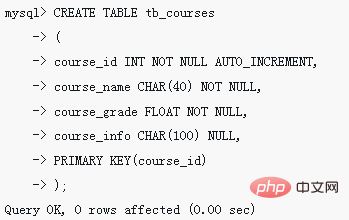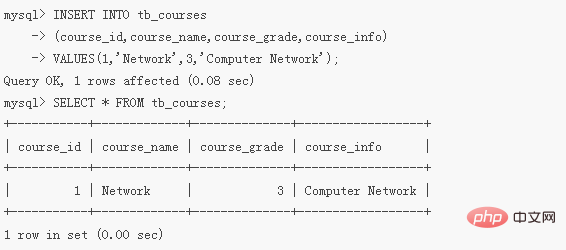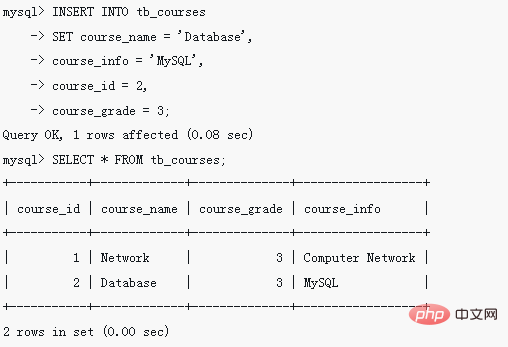在MySQL中可以使用INSERT语句向数据库增加一条记录数,INSERT语句有两种格式:1、“INSERT INTO 表名 [列名1,…列名n] VALUES (值1… , 值n);”,可以向表中插入一行全部列数据;2、“INSERT INTO 表名 SET 列名1=值1,列名2=值2,…;”,可以向表中插入一行部分列数据。

本教程操作环境:windows7系统、mysql8版本、Dell G3电脑。
在 MySQL 中可以使用 INSERT 语句向数据库已有的表中插入一行或者多行记录。
而INSERT 语句有两种语法形式,分别是 INSERT…VALUES 语句和 INSERT…SET 语句。
方法1:使用INSERT…VALUES语句增加一条记录数
语法格式为:
INSERT INTO <表名> [ <列名1> [ , … <列名n>] ] VALUES (值1) [… , (值n) ];
语法说明如下:
<表名>:指定被操作的表名。
<列名>:指定需要插入数据的列名。若向表中的所有列插入数据,则全部的列名均可以省略,直接采用 INSERT<表名>VALUES(…) 即可。
VALUES 或 VALUE 子句:该子句包含要插入的数据清单。数据清单中数据的顺序要和列的顺序相对应。
示例:
在 test_db 数据库中创建一个课程信息表 tb_courses,包含课程编号 course_id、课程名称 course_name、课程学分 course_grade 和课程备注 course_info
CREATE TABLE tb_courses( course_id INT NOT NULL AUTO_INCREMENT, course_name CHAR(40) NOT NULL, course_grade FLOAT NOT NULL, course_info CHAR(100) NULL, PRIMARY KEY(course_id) );

查看 tb_courses 表的数据
SELECT * FROM tb_courses;

在 tb_courses 表中插入一条新记录,course_id 值为 1,course_name 值为“Network”,course_grade 值为 3,info 值为“Computer Network”。
INSERT INTO tb_courses(course_id,course_name,course_grade,course_info) VALUES(1,'Network',3,'Computer Network');
插入后,在查询数据

可以看到插入记录成功。在插入数据时,指定了 tb_courses 表的所有字段,因此将为每一个字段插入新的值。
方法2:使用INSERT…SET语句增加一条记录数
语法格式为:
INSERT INTO <表名>
SET <列名1> = <值1>,
<列名2> = <值2>,
…此语句用于直接给表中的某些列指定对应的列值,即要插入的数据的列名在 SET 子句中指定,col_name 为指定的列名,等号后面为指定的数据,而对于未指定的列,列值会指定为该列的默认值。
示例:
在 tb_courses 表中插入一条新记录,course_id 值为 2,course_name 值为“Database”,course_grade 值为 3,info值为“MySQL”。
INSERT INTO tb_courses
SET course_name = 'Database',
course_info = 'MySQL',
course_id = 2,
course_grade = 3;插入后,在查询数据

可以看到插入记录成功。
说明:
INSERT 语句的两种形式:
使用 INSERT…VALUES 语句可以向表中插入一行数据,也可以插入多行数据;
使用 INSERT…SET 语句可以指定插入行中每列的值,也可以指定部分列的值;
采用 INSERT…SET 语句可以向表中插入部分列的值,这种方式更为灵活;
INSERT…VALUES 语句可以一次插入多条数据。
在 MySQL 中,用单条 INSERT 语句处理多个插入要比使用多条 INSERT 语句更快。
当使用单条 INSERT 语句插入多行数据的时候,只需要将每行数据用圆括号括起来即可。
【相关推荐:mysql视频教程】
以上就是mysql怎么增加一条记录数的详细内容,更多请关注php中文网其它相关文章!

每个人都需要一台速度更快、更稳定的 PC。随着时间的推移,垃圾文件、旧注册表数据和不必要的后台进程会占用资源并降低性能。幸运的是,许多工具可以让 Windows 保持平稳运行。




Copyright 2014-2025 https://www.php.cn/ All Rights Reserved | php.cn | 湘ICP备2023035733号